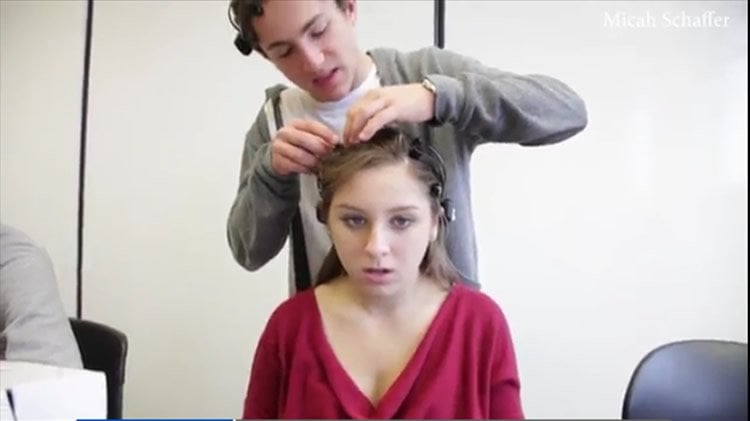Summary: A new study that utilizes EEG data finds students’ brains are in-sync when they are more engaged during classroom learning.
Source: Cell Press.
When people in a group are more engaged with each other and with the world around them, their brainwaves show remarkably similar patterns. That’s the conclusion of researchers who used portable EEG to simultaneously record brain activity from an entire class of high school students over the course of a full semester as they went about their regular classroom activities. The findings reported in Current Biology on April 27 highlight the promise of investigating the neuroscience of group interactions in real-world settings.
“We found that students’ brainwaves were more in sync with each other when they were more engaged during class,” says co-lead author Suzanne Dikker of New York University and Utrecht University. “Brain-to-brain synchrony also reflected how much students liked the teacher and how much they liked each other. Brain synchrony was also affected by face-to-face social interaction and students’ personalities. We think that all these effects can be explained by shared attention mechanisms during dynamic group interactions.”
The researchers, led by David Poeppel of New York University and the Max Planck Institute of Empirical Aesthetics, used portable EEG to simultaneously record the students’ brain activity. Researchers Lu Wan and Mingzhou Ding of the University of Florida then used novel analyses to assess the extent to which that brain activity was synchronized across students and how the degree of synchrony varied with class engagement and social dynamics.

The researchers think that the level of synchrony comes from a well-known phenomenon called neural entrainment. “Your brainwaves ‘ride’ on top of the sound waves or light patterns in the outside world, and the more you pay attention to these temporal patterns, the more your brain locks to those patterns,” Dikker explains. “So, if you and the person next to you are more engaged, your brainwaves will be more similar because they are locking onto the same information.”
Brain synchrony most likely supports synchronized behavior during human interaction. For example, synchrony is required for two or more people to have a good conversation, walk down the street, or dance, or carry a heavy piece of furniture. The findings suggest that social dynamics matter, even when people are just listening to the same lecture or watching the same video.
The researchers are now designing large-scale projects in which they’ll be able to record brain data and other biometrics from up to 45 people simultaneously in an auditorium. They hope to answer questions such as, “What are the ‘optimal’ conditions for an audience to experience a performance or movie? Is there an ideal group size? Does having some joint interaction right before a performance improve the experience? How does the audience affect the performer and vice versa?”
Funding: This research was supported by the National Science Foundation and a Netherlands Organisation for Scientific Research Award.
Source: Joseph Caputo – Cell Press
Image Source: NeuroscienceNews.com image is credited to Micah Schaffer; Student Video Crew: Luke Morrison, George Maguire, Jazon Zuriff, Cassidy Soloff.
Original Research: Full open access research for “Brain-to-Brain Synchrony Tracks Real-World Dynamic Group Interactions in the Classroom” by Suzanne Dikker, Lu Wan, Ido Davidesco, Lisa Kaggen, Matthias Oostrik, James McClintock, Jess Rowland, Georgios Michalareas, Jay J. Van Bavel, Mingzhou Ding, and David Poeppel in Current Biology. Published online April 27 2017 doi:10.1016/j.cub.2017.04.002
[cbtabs][cbtab title=”MLA”]Cell Press “When Students Pay Attention in Class, Their Brains Are in Sync.” NeuroscienceNews. NeuroscienceNews, 27 April 2017.
<https://neurosciencenews.com/student-attention-brain-sync-6521/>.[/cbtab][cbtab title=”APA”]Cell Press (2017, April 27). When Students Pay Attention in Class, Their Brains Are in Sync. NeuroscienceNew. Retrieved April 27, 2017 from https://neurosciencenews.com/student-attention-brain-sync-6521/[/cbtab][cbtab title=”Chicago”]Cell Press “When Students Pay Attention in Class, Their Brains Are in Sync.” https://neurosciencenews.com/student-attention-brain-sync-6521/ (accessed April 27, 2017).[/cbtab][/cbtabs]
Abstract
Brain-to-Brain Synchrony Tracks Real-World Dynamic Group Interactions in the Classroom
Highlights
•We report a real-world group EEG study, in a school, during normal class activities
•EEG was recorded from 12 students simultaneously, repeated over 11 sessions
•Students’ brain-to-brain group synchrony predicts classroom engagement
•Students’ brain-to-brain group synchrony predicts classroom social dynamics
Summary
The human brain has evolved for group living. Yet we know so little about how it supports dynamic group interactions that the study of real-world social exchanges has been dubbed the “dark matter of social neuroscience”. Recently, various studies have begun to approach this question by comparing brain responses of multiple individuals during a variety of (semi-naturalistic) tasks. These experiments reveal how stimulus properties, individual differences, and contextual factors may underpin similarities and differences in neural activity across people. However, most studies to date suffer from various limitations: they often lack direct face-to-face interaction between participants, are typically limited to dyads, do not investigate social dynamics across time, and, crucially, they rarely study social behavior under naturalistic circumstances. Here we extend such experimentation drastically, beyond dyads and beyond laboratory walls, to identify neural markers of group engagement during dynamic real-world group interactions. We used portable electroencephalogram (EEG) to simultaneously record brain activity from a class of 12 high school students over the course of a semester (11 classes) during regular classroom activities ( Figures 1 A–1C; Supplemental Experimental Procedures , section S1). A novel analysis technique to assess group-based neural coherence demonstrates that the extent to which brain activity is synchronized across students predicts both student class engagement and social dynamics. This suggests that brain-to-brain synchrony is a possible neural marker for dynamic social interactions, likely driven by shared attention mechanisms. This study validates a promising new method to investigate the neuroscience of group interactions in ecologically natural settings.
“Brain-to-Brain Synchrony Tracks Real-World Dynamic Group Interactions in the Classroom” by Suzanne Dikker, Lu Wan, Ido Davidesco, Lisa Kaggen, Matthias Oostrik, James McClintock, Jess Rowland, Georgios Michalareas, Jay J. Van Bavel, Mingzhou Ding, and David Poeppel in Current Biology. Published online April 27 2017 doi:10.1016/j.cub.2017.04.002






